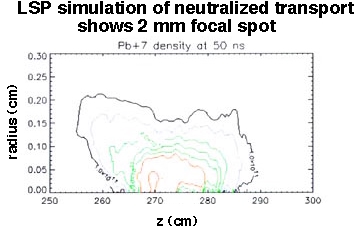LSP
LSP is a 3-D (as well as 2-D and 1-D) electromagnetic code developed by Mission Research Corporation for large-scale electromagnetic plasma simulations using the particle-in-cell method. The code runs on parallel as well as serial computers. On a parallel machine, domain decomposition with message-passing is used to divide the computational load among the processors. A unified decomposition of fields and particles is used, i.e. the particles reside on the same processor as the cells they occupy. The standard MPI message-passing interface is used for interprocess communication. Supported platforms include Windows 2000/NT/98, Linux, and UNIX.
Both explicit and direct-implicit electromagnetic field
and particle-advancing algorithms are available. Algorithms
are also implemented for field emission, transmission-line
boundaries, dielectrics, dispersive magnetic materials,
secondary electron generation, multiple scattering,
ionization of neutrals, surface heating, and desorption of
neutrals from surfaces. A hybrid fluid model for
electrons has been implemented, allowing electrons in dense
plasmas to be modeled with a kinetic or fluid treatment as
appropriate.
Memory allocation for both fields and particles is fully dynamic. The code saves on memory by not allocating field storage inside of conducting surfaces. A array of pointers is used to access field quantities. The particles are managed in groups, and groups are added as needed as the population increases.
LSP particle and field data files are written in XDR format, allowing binary data to be written, e.g., on a multi-processor Unix machine and viewed on, e.g., a PC or Macintosh. The history data file is an ASCII text file, and so is also portable. The P4 postprocessor, written in the cross-platform IDL language, is used to analyze output.
The graphical preprocessor GLSP preprocessor allows LSP input files to be generated graphically. It allows complete specification of a calculation and 3D visualization of the spatial elements. An LSP simulation can be launched from GLSP or the input data can be exported to a remote machine. GLSP is written with C and Tcl/Tk and uses OpenGL to render the objects in 3D space.
references
T. P. Hughes, R. E. Clark, and S. S. Yu, "Three-Dimensional Calculations for a 4 kA, 3.5 MV 2 Microsecond Injector with Asymmetric Power Feed," Phys. Rev. Spec. Topics Accel. Beams 2, 110401 (1999).
D. R. Welch, D. V. Rose. B. V. Oliver, and R. E. Clark,
"Simulation Techniques for Heavy Ion Fusion Chamber
Transport," Nucl. Instr. Meth. Phys. Res. A
464, 134 (2001).
For comments or questions contact WMSharp@lbl.gov or DPGrote@lbl.gov. Work described here was supported by the Office of Fusion Energy at the US Department of Energy under contracts DE-AC03-76SF00098 and W-7405-ENG-48. This document was last revised June, 2002.
